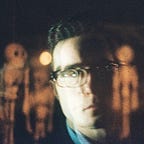THE BODY HEALS: An interview with Annelise Ogaard
Annelise Ogaard’s The Body Heals is a dreamy nonfiction dispatch from a plastic surgery slumber party in South Beach.
At its center, a woman examines the process of creating herself, still in that hazy, twilight period following her procedure, but before the bandages come off. Ogaard’s film begins as a verité-inflected document but slowly transforms into something stranger, bolder, and more subjective.
Ogaard answered a few questions about the film via email:
How did The Body Heals come about? What ideas were you hoping to explore within it?
The subject, Rachel, is actually a dear friend of mine, and more than anyone else I’ve ever met, she has a preternatural gift for self-performance. We all construct ourselves in one way or another, and often it’s pretty unconscious, but she’s fascinatingly deliberate and creative in the ways that she presents herself.
There’s so much scorn for women who are perceived as “fake.” Female artifice is pitied, trivialized, regarded with suspicion, endlessly critiqued, or defended with the wimpy refrain “Feminism Is About Choices :)”. When Rachel told me she was getting some work done, I saw the perfect opportunity to get past the tired moralizing and to explore femininity as a craft.
The cinematography, edit, and sound design of The Body Heals are excellent — what begins more as a exteriorized nonfiction dispatch slowly pulls inward, until Rachel’s subjectivity is almost weaponized against the viewer. Can you speak a little bit about how the form took shape, both in production and during post?
Thank you! I shot and edited it myself, which is a little atypical for me, but it felt necessary for a work this intimate. The woozy percocet score is by Paul Remund, and the mix was done by Dash Flanagan, who I’ve been collaborating with since my first film.
I had a loose shot list when I went down to Miami. I wanted a mix of verité and staged, atmospheric shots, but my more complicated ideas went out the window when the TSA held up the majority of my gear in Newark because they were scared of a spinning ring light I’d built (I was trying to copy a lighting set up from Clouzot’s Inferno). I was irate at first, but once I started shooting, I liked what I saw. Not having a tripod was a drag, but shooting the whole thing handheld makes it so much more intimate, even tactile. So, shoutout to the TSA, I guess?
In the edit, I built the film backwards starting from the last image, the one of Rachel looking at herself in the mirror. It’s almost the typical “after,” a piece of the familiar plastic surgery diptych — but its significance has changed because the you never see what came before. Instead of being invited to critique the way Rachel has altered her face, you just see her studying herself. Creating herself. I don’t know if her subjectivity is exactly “weaponized,” but showing female interiority on film is always a confrontation.
In the piece, Rachel comments that she doesn’t relate to sob stories that tend to hover around the decision to go under the knife — to her, plastic surgery was just an extension of daily rituals such as contouring and wearing padded bras and would be “a fun thing to do.” This also brings to mind ways of presenting and performing in a digital context that make our bodies malleable, iterative things (IG filters, Facetune, etc.) To what extent does The Body Heals relate to representations of the body online?
I saw an ad the other day for facial fillers with the slogan “Always camera ready.” Even just a couple years ago, staying “camera ready” was a concern for celebrities and their publicists, not the average person, but the proliferation of the camera phone has made all figures into public figures. Everybody has the tools and the mandate to construct a persona, a public image. In a lot of ways, Rachel is ahead of the curve.
This film premiered at (the great!) Borscht Diez down in Miami, which has placed a unique emphasis on commissioned short films as a way to help artists, especially first-generation Americans and others left behind by the film industry, learn craft and hone their voices on their own terms. Do you feel that working in the short form is satisfying and freeing? Or are there ideas you feel you can only fully explore at the feature length?
I was thrilled to premiere this at Borscht, because for a long time I’ve admired their commitment to their community, the work they produce and champion, and the way they turn all the way up.
There’s definitely a freedom to making short films, because I can work completely independently and realize my ideas without needing to raise a squillion dollars to do it.
At the same time, short films aren’t taken very seriously; they’re seen as practice or even proof of concept for a feature, which is frustrating and just plain dumb. I’m currently at work on my first feature film — a narrative, kind of an erotic horror movie — but I’m never going to abandon short form.
See more of Annelise Ogaard’s work on her website: anneliseogaard.com.
The Body Heals is currently streaming as part of Transmission 8 on Memory until September 17th.
It will screen again as part of D E E P IRL #1 at Nitehawk Cinema in Brooklyn on September 18th, with Ogaard present for a Q&A following the screening.
